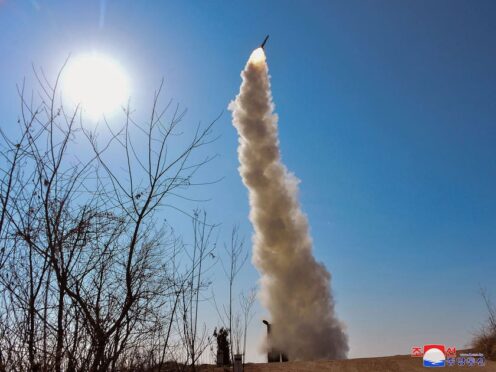North Korea said it has tested cruise missiles outfitted with new “super-large” warheads as well as a new type of anti-aircraft missile.
The report on Saturday by North Korean state media came a day after South Korea’s military said it detected the North launching multiple cruise missiles into waters off its western coast.
It is the country’s fourth round of launches in 2024.
North Korean photos of the test showed a low-flying cruise missile striking a target built on a coastal shore, and another projectile soaring into the air after being launched from ground.

North Korea’s official Korean Central News Agency (KCNA) did not specify the number of missiles tested or the details of their performance.
The agency said the tests were part of the country’s “normal activities” for military development and did not affect the security of neighbours.
Cruise missiles are among a growing collection of North Korean weapons designed to overwhelm regional missile defences. They supplement the country’s vast line-up of ballistic missiles, including long-range weapons aimed at the continental United States.
Analysts say anti-aircraft missile technology is an area where North Korea could benefit from its deepening military co-operation with Russia as the two countries align in the face of their separate, intensifying confrontations with the United States.
In January, North Korea conducted two tests of a new cruise missile designed to be launched from submarines, which leader Kim Jong Un described as a meaningful step toward his goals of building a nuclear-armed navy.
The North also conducted tests of a long-range cruise missile, which it has described as nuclear-capable and can cover ranges of up to 1,240 miles — potentially putting US military bases in Japan within reach.

Those cruise missile tests followed the January 14 launch of a new solid-fuel intermediate-range missile, which underscored North Korean efforts to advance weapons that could target US assets in the Pacific, including the military hub of Guam.
Friday’s launches came hours after North Korean state media reported that Mr Kim reiterated his focus on strengthening his naval forces as he inspected the construction of warships at a shipyard in Nampho on the west coast.
In recent months, Mr Kim has emphasised efforts to build a nuclear-armed navy to counter what he portrays as growing threats posed by the United States, South Korea and Japan, which have stepped up their military cooperation in response to his nuclear ambitions.
There are concerns that Mr Kim, emboldened by the steady advancement of his nuclear arsenal and strengthened ties with Russia, would further ramp up pressure against his rivals in an election year in the United States and South Korea.
Experts say Mr Kim’s long-term goal is to force the US to accept the idea of the North as a nuclear power and negotiate security concessions and sanctions relief from a position of strength.
